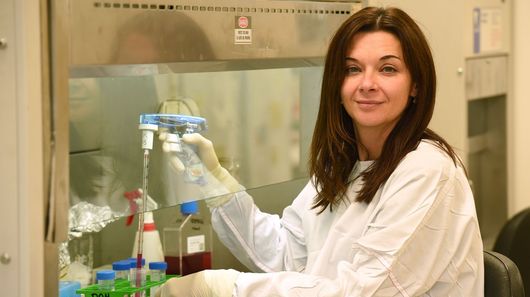Immune system discovery could lead to one-jab universal flu shot
May 17, 2015

Associate Professor Katherine Kedzierska, part of the team that made the flu-immunity discovery, at work in the University of Melbourne lab (Credit: University of Melbourne)
An international team of researchers claim to have uncovered how human immune cells remember previously encountered strains of influenza. This discovery may pave the way to the development of a single universal flu shot to immunize people against all strains of the infectious disease for their entire lives.
Influenza is a virulent and infectious virus that affects countless scores of people worldwide, and has resulted in several pandemics that have killed millions. One of the reasons that influenza is so hard to eradicate or inoculate against is the fact that it mutates so often, meaning the immune system can’t quickly swing known methods into action to combat it.
A new breakthrough breakthrough involves an understanding of how "killer" CD8 + T cells – part of the body’s active immune system that travel throughout the body hunting down specific pathogens – remember previously encountered virus strains.
In simple terms, killer T cells hunt and destroy cells that are infected with viruses (and other diseases or problems). They are activated when their specific receptor binds to an antigen complex (that is, the proteins found on the surface of a pathogen) aided by a co-receptor on the T cell, which alerts it to the antigen’s presence. When activated, the T cell searches out cells with this antigen and destroys them.
No previous studies had managed to fully ascertain how killer T-cells remembered which viruses had been encountered before, and it was not until the Australia-Sino collaboration during the outbreak of the bird-borne H7N9 influenza virus in China in 2013 that this mechanism was uncovered. With a 30 percent mortality rate and an almost 100 percent hospitalization rate for those infected, the H7N9 strain was particularly virulent, but also offered researchers the opportunity to come to grips with the virus’ infection methods first-hand.
"We’d never seen anything like H7N9," said Associate Professor Kedzierska from the University of Melbourne. "The virus was infecting more people rapidly and nobody had immunity. Thankfully, we did manage to contain the virus but we knew we had come face-to-face with a potential pandemic that could kill millions of people around the world if the virus became able to spread between humans. After collecting samples from infected patients we found that people who couldn’t make these T cell flu assassins were dying. These findings lead to the potential of moving from vaccines for specific influenza strains toward developing a protection, which is based on T-cells."
In discovering that the CD8 + T cell response to new pathogens is directly related to an individual body’s ability to activate these effector mechanisms, the team claims to have unravelled the requirements to initiate these immune responders no matter the influenza strain present. In other words, knowing the mechanism found in the influenza virus itself (and common to all strains) required to activate an immune response may lead to the development of inoculations that provide T-cells with the ability to recognize any influenza virus, not just particular strains.
"Our extraordinary breakthrough could lead to the development of a vaccine component that can protect against all new influenza viruses, with the potential for future development of a one-off universal flu vaccine shot," said Associate Professor Kedzierska. "This work will also help clinicians to make early predictions of how well a patient’s immune system will respond to viruses so they can manage early interventions such as artificial ventilation more effectively, particularly in cases where the patient is at risk of dying."
This work was led by the University of Melbourne, the Shanghai Public Health Clinical Center and Fudan University in China, with assistance from scientists at St Jude Children’s Research Hospital, in Memphis, Tennessee.
The results of this research were recently published in the journal Nature Communications.
Source: The University of Melbourne
copyright © Gizmag 2003 - 2015
http://www.gizmag.com/vaccine-component-influenza-virus/37499